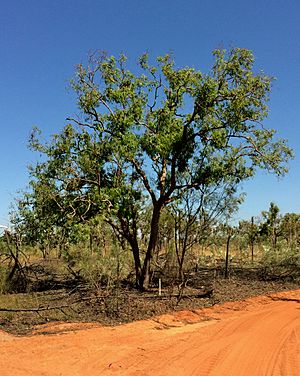Long-fruited bloodwood facts for kids
Quick facts for kids Long-fruited bloodwood |
|
|---|---|
 |
|
| Long-fruited bloodwood, Kimberley, WA, Australia |
|
| Scientific classification | |
| Genus: |
Corymbia
|
| Species: |
polycarpa
|
| Synonyms | |
|
|
The Corymbia polycarpa, also known as the long-fruited bloodwood, is a special tree found only in northern Australia. It is also called the small-flowered bloodwood.
Different Indigenous Australian groups have their own names for this tree. For example, the Nungali people call it narrga or gunjid. The Mulluk-Mulluk people know it as dawart, and the Yangman people call it bodog. The Gurindji peoples use the name jadburru, and the Wagiman people call it jagatjjin.
This tree is medium-sized. It has rough, flaky bark on its trunk and branches. Its adult leaves are shaped like a spear or are slightly curved. The flowers are white or cream-coloured and grow in groups. After flowering, the tree produces barrel-shaped fruits.
Contents
What the Long-Fruited Bloodwood Looks Like
The long-fruited bloodwood tree usually grows to be about 5 to 15 metres (16 to 49 feet) tall. Sometimes, it can even reach 25 metres (82 feet) high. It has a special woody swelling at its base called a lignotuber. This helps the tree regrow after fires.
Bark and Leaves
The bark on the trunk and branches is rough and flaky. It can be brownish. Older bark is grey-brown, while newer bark is reddish-brown.
Young plants have oval or spear-shaped leaves. These leaves can be up to 250 millimetres (10 inches) long. Adult leaves are usually shiny green. They are a bit paler on the underside. These leaves are also spear-shaped or curved. They are about 78 to 208 millimetres (3 to 8 inches) long.
Flowers and Fruit
The tree's flower buds grow at the ends of its branches. They are arranged in groups of seven or nine buds. Each bud is oval or pear-shaped. They are about 9 to 14 millimetres (0.35 to 0.55 inches) long. The buds have a whitish, scaly surface.
The long-fruited bloodwood flowers between April and August. Its flowers are white or cream-coloured.
After the flowers, the tree produces woody, barrel-shaped fruits. These fruits are about 15 to 35 millimetres (0.59 to 1.38 inches) long. Inside the fruit are brown, oval-shaped seeds. Each seed has a small wing on its end.
Where the Long-Fruited Bloodwood Grows
The long-fruited bloodwood is found across northern Australia. You can see it in Western Australia, the Northern Territory, Queensland, and even in northwestern New South Wales.
It is very common between Broome and Derby in Western Australia. It also grows throughout the Kimberley region. From there, it spreads east across the Top End of the Northern Territory. This includes nearby islands. It also grows across the Gulf of Carpentaria and the southern Cape York Peninsula in Queensland.
This tree often grows near rivers or in low areas. It likes sandy or silty soil. Sometimes, it can be found in rocky or clay soils.
How People Use the Long-Fruited Bloodwood
The wood from this tree is very strong and lasts a long time. If used above ground, it can last over 40 years. If used in the ground, it can last about 25 years.
However, termites can attack the wood. Also, a type of beetle called a lyctine borer can damage the sapwood. It is a very hard wood, so it's tough to work with using hand tools.
Because it has many sticky, reddish veins (called kino veins), it is often used as whole poles rather than cut timber. People have used it for fence posts, railway sleepers, and supports in mines. It has also been used for house stumps.
Indigenous Australian people used the tree's gum for medicine. They used it as a liquid to clean and treat cuts, sores, burns, and other skin problems.
Images for kids
See also
 In Spanish: Corymbia terminalis para niños
In Spanish: Corymbia terminalis para niños


